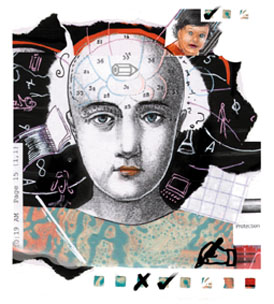Are you a journalist? Please sign up here for our press releases
Subscribe to our monthly newsletter:

Brain researchers aim to map nerve cell clusters in action, "conversing" with their peers, processing sensory information, or performing cognitive functions. Each cluster, containing thousands of nerve cells performing a given task, is called a cortical column. The ability to obtain an exact mapping of these columns, which serve as the brain's "microprocessors," is critical to understanding sensory perception and higher cognitive functions. Yet until recently, explorations of the human brain have had to rely on indirect methods with limited accuracy, such as positron emission tomography (PET) and functional magnetic resonance imaging (f-MRI). While these techniques can be used to map an active area at an accuracy of 2-7 mm, mapping brain microprocessors requires an accuracy of 0.5 mm.
In the past 15 years, Prof. Amiram Grinvald of the Weizmann Institute's Neurobiology Department has developed optical imaging - a brain-mapping approach that tracks color changes in the blood ferrying oxygen to active microprocessors. Using this technology, Grinvald was able to identify the exact time and place in which nerve cells consume oxygen from the microcirculation system. The high resolution permitted detailed mapping of individual cortical columns.
Optical imaging laid the foundation for developing functional MRI by Seiji Ogawa and colleagues at AT&T. Initially scientists had hoped that using f-MRI would enable brain mapping with the same accuracy as that obtained by optical imaging. Indeed, both methods detect a considerable "delayed activity peak" that appears roughly six seconds after the onset of electrical activity. Yet the f-MRI systems could not detect the initial dip," a negative signal that appears earlier, which is clearly visible with optical imaging.
This is where things stood until recently, when Grinvald and colleagues published a paper in Science, suggesting how to enhance f-MRI resolution. Now, a team of researchers from Minnesota University has adopted this recipe and found the missing initial dip using high strength magnetic field f-MRI. The marked improvement in f-MRI should assist attempts to probe human cognition and perception. "f-MRI is far more suitable for non-invasive human brain research and clinical applications than optical imaging or PET," says Grinvald. "It may be used to explore the same brain for many years, enabling researchers to track and map memory traces, aging processes, or functional recovery from trauma or stroke."
And the Minnesota team has already collected the first rewards - the first exact mapping of orientation columns, microprocessors responsible for shape perception in the visual cortex.
Prof. Amiram Grinvald holds the Helen and Norman Asher Professorial Chair in Brain Research. His research is supported by the Horace W.Goldsmith Foundation, New York, Murray Meyer Brodetsky Center of Higher Brain Functions, Mrs. Margaret M. Enoch of New York, the Simon and Marie Jaglom Foundation, New York, and the Carl and Michaela Einhorn-Dominic Brain Research Institute, France.